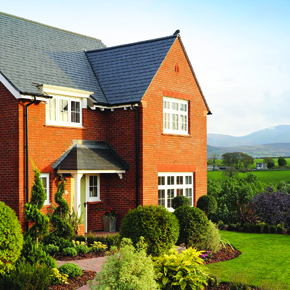
Fire, safety & security: building-in certainty
New regulations in home security are a welcome development, however specifiers need to be aware of how the regulations will work with current fire safety standards, cautions Jon Cole, national operations manager of Police initiative, Secured by Design…
The introduction of Approved Document Q (ADQ) or Part Q (Security: Dwellings) in October last year, saw guidelines on physical security in housing included in the Building Regulations for the first time.
The new ADQ regulations apply to doors, windows and rooflights in new homes and where there is a change in use to an existing building to create new dwellings, with specified products required to meet new minimum standards for resistance to attack.
The legislation has been welcomed by Police initiative, Secured by Design (SBD), which has been working for the last 26 years to support the principles of designing-out crime through physical security and design.
While ADQ sets the minimum test standards that must be met, it falls short of providing specifiers with the detailed information needed to ensure that they specify the correct products for a particular application – which can require additional elements relating to their use or an understanding of possible conflicting Building Regulations.
Of particular significance is the potential overlap between ADQ and fire safety regulations, as outlined in the pre-existing Approved Document B. Last updated in 2013, Approved Document B (ADB) or Part B (Fire Safety) lays down minimum requirements for the fire performance of materials, products and structures used.
Incorporating new measures to ensure the security of vulnerable entry points, while maintaining compliance with existing fire safety regulations, presents additional complexities.
Also, with the introduction of ADQ, the onus now falls on developers and specifiers to collaborate in meeting both requirements. Building control officers also have a responsibility to ensure specified products are fit-for-purpose in respect of both fire and security compliance.
Taking the wider view

“An holistic approach is essential, not only to ensure you stay on the right side of the law but to avoid what could easily be a tragedy in the making…”
Both ADQ and ADB require products and materials used to be tested to ensure they meet accepted British Standards. While, technically, compliance may exist where the required testing has been carried out for individual elements, assessing these results in isolation can be misleading, if not dangerous.
The scope of certification for each design requirement (fire or security) will differ in many cases. It would not be unusual, for example, for there to be differences in glazing specification, lock or hardware arrangements; this may include the installation of an internal integral doorcloser (which requires material to be removed from the door leaf) which performs an important task in a fire door, but may well have a dramatic effect on the structural integrity of a door leaf when subjected to a security test.
There are numerous other examples, but the important message has to be: If a fire doorset is being installed in a new building and now needs to be secure, in accordance with Part Q, then it must be subjected to the security test in the same configuration/specification as it was for the fire test.
Example: Getting it right – door glazing
Available options for glazing include fire-rated glass, security-rated glass and fire-rated security glass.
Viewed in isolation, test results may suggest all obligations under ADQ and ADB respectively have been adequately discharged, when the reality is that the requirement is for fire-rated security glass. In this case, incorrect specification could result in either the fire safety or the security of the door being compromised.
The need for joined-up thinking is even more critical when considering the situations in which both regulations apply. In particular, in protecting vulnerable residents in communal housing from attack – in student accommodation for example – or in high risk spots such as doors leading from basement car parks into communal areas. Taking an holistic approach is essential, not only to ensure you stay on the right side of the law but to avoid what could easily be a tragedy in the making.
Find out more in the February issue of ABC+D Magazine
Latest news

21st February 2025
ASSA ABLOY EMEIA: Save valuable time and money with a seamless switch to programmable digital keys
In 2025, access management can be a whole lot easier. By making access part of their digital processes, businesses can put time-consuming key management and the cost of changing the locks firmly behind them. Making this switch is a lot easier than many people think, as ASSA ABLOY explains here…
Posted in Access Control & Door Entry Systems, Architectural Ironmongery, Articles, Building Industry News, Building Products & Structures, Building Services, Doors, Facility Management & Building Services, Health & Safety, Information Technology, Innovations & New Products, Retrofit & Renovation, Security and Fire Protection
21st February 2025
Showersave supports industry leaders in addressing Part L and Part G regulations
Showersave has sponsored and participated in a recent Building Insights LIVE roundtable on ‘Water & Energy Saving Innovations in New Build Housing’.
Posted in Articles, Bathrooms & Toilets, Bathrooms, Bedrooms & Washrooms, Building Associations & Institutes, Building Industry Events, Building Industry News, Building Products & Structures, Building Regulations & Accreditations, Building Services, Exhibitions and Conferences, Interiors, Pipes & Fittings, Plumbing, Retrofit & Renovation, Sustainability & Energy Efficiency
21st February 2025
GEZE: The importance of Specifying High Quality Door Closers on Fire Doors
Andy Howland, Sales & Marketing Director at GEZE UK, discusses why specifying high quality door closers on fire doors is important…
Posted in Access Control & Door Entry Systems, Accessibility, Architectural Ironmongery, Articles, Building Industry News, Building Products & Structures, Building Regulations & Accreditations, Building Services, Doors, Facility Management & Building Services, Health & Safety, Posts, Restoration & Refurbishment, Retrofit & Renovation, Security and Fire Protection
21st February 2025
Insight Data achieves ISO9001 recertification with zero non-conformities
Leading industry data specialist, Insight Data, has successfully achieved the prestigious recertification for ISO9001 with zero non-conformities for the fourth consecutive year.
Posted in Articles, Building Industry News, Building Regulations & Accreditations, Building Services, Information Technology, Research & Materials Testing
 Sign up:
Sign up: 